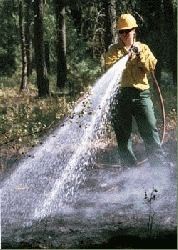Fire prevention starts with you
Published 12:00 am Thursday, October 4, 2001

- Flames that appeared to have spread from a campfire ring nearly set the woods ablaze in August 2000 in this scene west of Baker City. Oregon Department of Forestry and rural firefighters doused the woodland fire. (Baker City Herald photograph by S. John Collins).
By JAYSON JACOBY
Trending
Of the Baker City Herald
A fire may feel fine on falls frosty mornings, but flames and even sparks remain a threat to Baker Countys parched forests and rangelands.
And what really frightens fire officials is this: A person can spark a blaze and never even know it.
Trending
The most irresponsible camper knows an unattended campfire can escape its ring of rocks.
But how many visitors ponder the possibility of their sport-utility vehicles catalytic converter igniting the patch of tall, dry grass where they parked the rig?
Or that their four-wheelers clogged spark arrestor might be ejecting hot little embers every time they shift into low gear?
People just need to be real cautious, said Miles Hancock, who works at the Northeast Oregon Interagency Fire Dispatch Center in La Grande.
Hancock said the regions forests and ranges are as dry now as theyve been all year.
Earlier this week firefighters had to put out three human-caused fires in the Elkhorn Mountains southwest of Baker City.
Investigators dont yet know how those blazes started.
None burned more than half an acre, but weather conditions warm, dry afternoon and gusty winds the next couple days are conducive for a fire to get out of control fast, said Larry Aragon, fire management officer at the La Grande Ranger District.
But both Aragon and Hancock said recreationists can greatly reduce the risk of starting a fire by adhering to some simple precautions.
They still need to be very careful, Aragon said.
Warming fires
Fires in developed campgrounds rarely get away, Aragon said.
By far the bigger threat is from the blazes people sometimes start to take off the morning chill while theyre hunting or hiking away from camp.
The problem, he said, is that people either dont properly prepare the site where they build their warming fire, or they walk away from it before its actually out.
Preparing the site is easy, Hancock said just sweep the ground down to bare dirt.
Then, before you leave, make sure the fire is dead out.
The difficulties come from the way people define that term, Hancock said.
Many people figure dead out means there are no visible flames, he said.
But fire officials dont call a fire dead out until they can run a bare hand through the embers and not feel any heat, Hancock said.
Just because there arent active flames doesnt mean the fire is out, he said. A lot of times they do come back to life, especially on these warm, windy afternoons.
The easiest and fastest way to render a fire dead out is to douse it with water and mix the moisture into the ashes, he said.
Plain dirt works, too, but it will take longer.
A popular practice is to ignite an old pitchy stump for warmth. They make a nice fire, but they also can burn and burn and burn, Aragon said.
Rigs, and other things with motors
All motorized equipment, including chain saws and generators as well as vehicles, are supposed to be equipped with a spark arrestor that meets standards of the U.S. Department of Agriculture.
But not all do, Aragon said.
And even on motors so equipped, the spark arrestor may not function properly, especially if its old and hasnt been maintained.
But sparks from the exhaust pipe arent the only potential firestarters, Aragon said.
Catalytic converters, which are installed on most vehicles built within the past 25 years or so, usually are the hottest external parts on a vehicle, he said.
He urges drivers to look around whenever they stop, even if they just pull over for a moment to check a map.
Aragon said he knows of many instances in which a driver parked for only a minute, then drove away without realizing the catalytic converter or muffler had ignited roadside grass or brush.
Smoking
It seems obvious that flicking a cigarette out the window of a vehicle is a bad idea, but Aragon said its a habit that can be hard to break.








